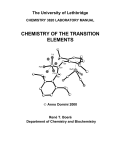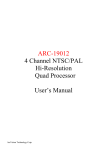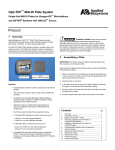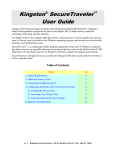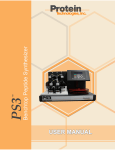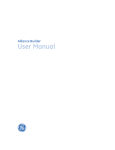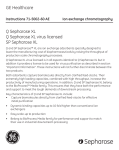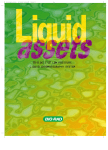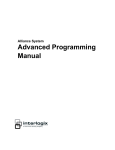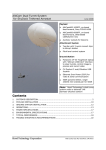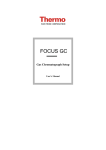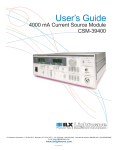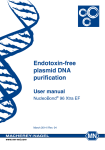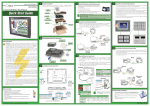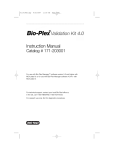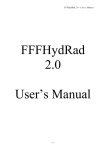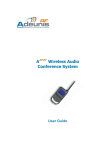Download UNOsphere SUPrA™ Affinity Chromatography Media - Bio-Rad
Transcript
10014430B:4110109C.qxd 7/1/2009 11:43 AM Page COV3 ................................................................................................................................ UNOsphere SUPrA™ Affinity Chromatography Media Instruction Manual Catalog #s 156-0218 156-0219 156-0220 156-0221 156-0222 156-0250 Please read these instructions prior to using UNOsphere media. If you have any questions or comments regarding these instructions, please contact your Bio-Rad Laboratories representative. 10014430B:4110109C.qxd 7/1/2009 11:43 AM Page COV4 10014430B:4110109C.qxd 7/1/2009 11:43 AM Page I Table of Contents Section 1 Introduction ...................................................................1 Section 2 Technical Description ....................................................2 Section 3 Preparation for Packing.................................................3 3.1 Determining Slurry Percentage or Media Volume................4 Section 4 Column Packing.............................................................4 4.1 Packing in Open Column Systems .....................................4 4.2 Packing in Closed Column Systems...................................5 4.3 Stall-packing Closed Column Systems...............................6 Section 5 Column Packing Evaluation ...........................................6 Section 6 Screening Conditions ....................................................8 Section 7 Operation and Maintenance ..........................................9 Section 8 Cleaning-In-Place (CIP)..................................................9 Section 9 Sanitization..................................................................10 Section 10 Storage ........................................................................10 Section 11 Regulatory Support ......................................................10 Section 12 Ordering Information ...................................................10 10014430B:4110109C.qxd 7/1/2009 11:43 AM Page II 10014430B:4110109C.qxd 7/1/2009 11:43 AM Page 1 Section 1 Introduction UNOsphere SUPrA™ media are affinity chromatography support based on recombinant protein A. The media are designed for process-scale purification of monoclonal antibodies. The protein A ligand is produced in E. coli without the use of material from animal origin. The UNOsphere base bead is a macroporous polymeric bead that is designed for robust and scaleable process applications. See Table 1 in the next section for the technical description of the product. The outstanding flow pressure performance of UNOsphere chromatography media allows its use in large-scale process applications. The flow characteristics of UNOsphere SUPrA can be found in Figure 1 in section 2 of this manual. UNOsphere SUPrA affinity chromatography media come with full regulatory support and are backed by the support of Bio-Rad’s global application and development team. 1 10014430B:4110109C.qxd 7/1/2009 11:43 AM Page 2 Section 2 Technical Description Composition Particle Size Range Ligand Coupling Chemistry Dynamic Binding Capacity1 Chemical Stability2 Working pH Range Cleaning-In-Place (CIP) Recommended Mobile Phase Velocity Range Working Temperature Range Delivery Conditions Storage Conditions Highly Crosslinked Polymer 53–61 µm Recombinant Protein A Epoxy 150 cm/hr 30 ± 3 mg/ml 300 cm/hr 25 ± 2 mg/ml 450 cm/hr 20 ± 2 mg/ml 10 mM Hydrochloric acid 6 M Guanidine hydrochloride 0.1 M Arginine (pH 2.8) 0.1 M Citrate (pH 2.8) 0.1 M Glycine (pH 2.8) 3–11 6 M Guanidine hydrochloride 10 mM Hydrochloric acid 0.1 M Sodium hydroxide 1 M Acetic acid/20% Ethanol 100–600 cm/hr 2–40ºC 50% slurry in 20% Ethanol 2–8ºC 1 Minimum 20 mg/ml at 300 cm/hr; 10% breakthrough capacity determined with 1.0 mg/ml polyclonal human IgG in 1.1 x 10 cm column 2 No significant change in chromatographic performance after 24 hr storage at room temperature. 2 10014430B:4110109C.qxd 7/1/2009 11:43 AM Page 3 3.0 2.5 Pressure (bar) 2.0 1.5 1.0 0.5 0.0 0 100 200 300 400 500 600 700 Linear flow (cm/hr) Fig. 1. Flow performance of UNOsphere SUPrA™ media in Bio-Rad InPlace™ column (20 cm x 20 cm) packed to 13% axial compression. Section 3 Preparation for Packing UNOsphere SUPrA affinity chromatography media are supplied fully hydrated in 20% ethanol as a 50% (v/v) slurry. For column packing, removal of the shipping buffer is recommended. Small volumes of UNOsphere media are easily washed in a Büchner funnel with 4–5 volumes of packing buffer. For large volumes, cycling through 3–4 settling and decanting steps with packing buffer is recommended. Complete removal of fine particles from UNOsphere SUPrA media is not required since the media are manufactured with a very narrow particle size range. If fine particles (fines) have been generated during handling, resuspend (reslurry) the media, let settle, then decant the supernatant containing the fines. Repeat this process several times until a clear supernatant is obtained. When preparing a homogenous slurry from settled material, take special care not to crush the settled media with a mixing paddle; this can create fines. Use a side-to-side motion or J-stroke with a PTFE mixing paddle or other plastic paddle to disturb the top layers of the settled bed until the slurry becomes homogenous. Alternatively, gently roll the sealed container back and forth in a rocking motion to resuspend the media. 3 10014430B:4110109C.qxd 7/1/2009 11:43 AM Page 4 3.1 Determining Slurry Percentage or Media Volume The recommended slurry percentage for column packing is 30–50%. There are several methods that can be used to determine the slurry percentage of a solution. Using disposable open columns (e.g. Bio-Rad Econo-Pac® columns): Method 1: Fill the column with slurry and use a marker to indicate the filled height. Open the bottom of the column and drain the buffer. Mark the bed height of the remaining media. The height of the remaining media divided by the height of the total slurry volume will yield the approximate slurry percentage. Method 2: Pour slurry into a graduated cylinder and allow to settle overnight (>12 hrs). The height of the settled bed divided by the height of the total volume will yield the approximate slurry percentage. Method 3: If the media are packed into a column, flow at 300 cm/hr with the top flow adapter at least 10 cm above the packed bed. Stop the flow and open the top of the column. Allow the bed to rebound for at least 15 min to determine the bed volume prior to compression. Section 4 Column Packing General column packing procedures are outlined below for the two main process scale column types (open and closed column systems). Please consult the user guide of the specific column you are using for complete instructions. See Figure 1 for the flow properties of UNOsphere SUPrA media. Caution: Some column systems require recirculation of slurry for extended periods through the packing pump. Avoid this operation with UNOsphere SUPrA™ media, as vigorous recirculation can damage the media and create an excessive amount of fine particles. Consult Bio-Rad Technical Services for alternate methods. 4.1 Packing in Open Column Systems • Completely remove top piston assembly. Make sure the column is level • Ensure that there is no air trapped in the bottom process valve or frit by performing a brief up-flow with packing buffer, or by pouring packing buffer into the column and allowing it to drain • Leave about 2 cm of packing buffer at the bottom of the column. Close the bottom process valve 4 10014430B:4110109C.qxd 7/1/2009 11:43 AM Page 5 • Carefully transfer the slurry to the column (using the pre calculated volume). Slurry can be transferred using a diaphragm pump or other gentle transfer method • Allow the slurry to settle until a 2–5 cm layer of clear supernatant packing buffer is observed above the bed • Replace the top flow adapter (piston assembly) and lower into supernatant layer • Engage the seal. Lower the top piston in order to remove any trapped air and purge the top piston assembly of air • Once all of the air is removed, begin flow packing at approximately 300 cm/hr. This value may change depending on your process requirements o Columns equipped with speed-controlled dynamic axial compression capabilities (such as Bio-Rad® EasyPack™ columns) can be packed using a combination of flow packing and axial compression, or only using axial compression o Columns without axial compression capabilities may be flow-packed • The optimal compression percentage for UNOsphere SUPrA™ media is 12% 4.2 Packing in Closed Column Systems Using Bio-Rad® InPlace™ Columns Bio-Rad InPlace columns are typically packed using a Bio-Rad® media transfer device and a slurry tank. The slurry tank should be filled with slurry at 30–50% concentration, and should be equipped with a low-shear impeller for gentle mixing. • The column should be cleaned and levelled with the piston lifted to the uppermost position • Ensure that there is no air trapped in the bottom process valve or frit by reverse flowing with packing buffer for a short period or by introducing packing buffer into the column and allowing it to drain • Verify that about 2 cm of packing buffer remains at the bottom of the column. Close the bottom process valve • The seal may be deflated prior to slurry transfer • Using the media transfer device, open the slurry valves. Open the bottom valve on the slurry tank to allow the transfer of slurry into the InPlace column. Turn on the diaphragm pump to increase the speed of transfer • After completing the slurry transfer, rinse the slurry tank and transfer lines with reserved buffer. Close the slurry valves 5 10014430B:4110109C.qxd 7/1/2009 11:43 AM Page 6 • Allow the slurry to settle until a 2–5 cm layer of clear supernatant packing buffer is observed above the settled bed • Lower the top piston into supernatant layer and engage the seal. Continue to lower the top piston to remove any trapped air and to purge the top piston assembly of air • After ensuring that all of the air has been removed, begin flow packing at approximately 300 cm/hr. This value may change depending on your process requirements o Columns equipped with speed-controlled dynamic axial compression capabilities (such as the Bio-Rad EasyPack™ column) may be packed using a combination of flow packing and axial compression, or simply by using axial compression. o Columns without axial compression capabilities may be flow-packed without any precaution • The optimal compression percentage for UNOsphere SUPrA media is 12% 4.3 Stall-Packing Closed Column Systems When using process scale closed column systems that require stall packing, consult the user manual of your specific column model. Section 5 Column Packing Evaluation After the completion of the packing operation, it is highly recommended and often routine to verify the quality of the packing. This verification can also be done at anytime throughout the lifetime of the packed bed to verify efficiency. The verification consists of determining height equivalent to theoretical plate (HETP) as well as the asymmetry factor (As). To determine HETP, equilibrate the column with 3–5 column volumes (CV) of starting buffer or until a baseline conductivity (or UV) trace is achieved. To test the effectiveness of column packing, inject a sample of a low molecular weight, unretained compound (e.g., acetone or 1 M NaCl). If acetone is used as the test marker (use an absorbance monitor set at 280 nm), the starting buffer must have a salt concentration less than 100 mM. If 1 M NaCl is the test marker (use a conductivity monitor), then the testing buffer salt concentration should be 100–200 mM. The sample injection volume should be 1–3% of the total column volume. The column testing should be performed at approximately 100 cm/hr. 6 10014430B:4110109C.qxd 7/1/2009 11:43 AM Page 7 To obtain comparable HETP values between columns, the same conditions must be applied. The number of theoretical plates is often expressed in terms of plates per meter (N/m) to normalize for column bed height. Minimum theoretical plate values should be approximately 4,000–7,000 plates/m. However, since protein A-based separations are not plate-based, obtaining a particular number of theoretical plates/meter is not required. HETP = L/N N = 5.54 (Ve/W½h)2 L = Bed height (cm) N = Number of theoretical plates Ve = Peak elution volume or time W½h = Peak width at peak’s half height in volume or time Ve and W½h should always be in the same units. Note: Peaks should be symmetrical without significant leading or trailing shoulders. A split peak may indicate a cracked bed which requires repacking. Peak asymmetry factor calculation: See Figure 2 As = b/a a = Front end of peak width at 10% of peak height bisected by line denoting Ve b = Back end of peak width at 10% of peak height bisected by line denoting Ve 7 10014430B:4110109C.qxd 7/1/2009 11:43 AM Page 8 Fig. 2. A simulated chromatography profile from which HETP and As values are calculated. Section 6 Screening Conditions Because different antibodies will have differing levels of affinity for UNOsphere SUPrA™ media, it is highly recommended to assess the behavior of the target antibody on the media. To do so, it is best to test for binding under conditions that will bind the widest range of antibodies, followed by a linear elution protocol to assess optimal elution conditions, before further refining the method. It is important before undertaking this process to ensure that the target antibody is stable and soluble under the full range of conditions used for the screening. Using a BioScale™ Mini column (1 or 5 ml) packed with UNOsphere SUPrA media A: 0.02 M sodium phosphate, 0.02 M sodium citrate, pH 7.5. B: 0.02 M sodium citrate, 0.1 M sodium chloride, pH 3. Equilibrate column the with 10 CV buffer A (see note below). Inject a small sample of antibody either as is, or at 1:10 dilution in buffer A (see note below). Wash the loaded columns with buffer A, until effluent absorbance returns to baseline. Elute with a 10 CV linear gradient to buffer B; collect fractions. Wash the column with 5 CV buffer B. Note: Boric acid may be added to the binding/equilibration buffer to obtain a higher pH range. Up to 1M sodium sulfate may be added to enhance binding. 8 10014430B:4110109C.qxd 7/1/2009 11:43 AM Page 9 Section 7 Operation and Maintenance UNOsphere SUPrA™ media are designed to achieve high productivity, usability and scalability, to allow users to process at high linear velocities. A linear flow rate of up to 600 cm/hr is well within the operational capabilities of the media. UNOsphere SUPrA media can be used with all buffer systems common in monoclonal antibody purification. The media are also designed to withstand multiple compression and decompression cycles at the recommended compression rate of 12% . Section 8 Cleaning-in-Place (CIP) During operation it is recommended that the column bed be periodically cleaned to remove bound substances that can adversely impact the separation performance of the column. The accumulated substances fall into two general categories: a) difficult to remove precipitated or denatured substances, and b) substances that are hydrophobically bound to the column bed. To ensure that all bound substances are released and washed out of the column, the following CIP cleaning protocols are recommended. CIP Protocols The following protocols are suggested to remove precipitated or denatured substances from the bed. Wash the bed with 2–5 column volumes in reverse flow with one of the following solutions: • 6 M guanidine hydrochloride • 10 mM hydrochloric acid • 0.1 M sodium hydroxide* • 1 M acetic acid/20% ethanol Followed by a reverse flow wash with at least 5 column volumes of binding buffer at neutral pH (7-8). To remove any hydrophobically bound substances from the bed, wash the column with 2–5 column volumes in reverse flow of a non-ionic surfactant/detergent, followed by a reverse-flow wash with at least 5 column volumes of binding buffer at neutral pH. * Suggested contact time per cycle is 15 min at room temperature. 9 10014430B:4110109C.qxd 7/1/2009 11:43 AM Page 10 Section 9 Sanitization If microbial contamination of the packed bed is suspected, the column can be periodically washed with a solution consisting of 0.1 M sodium hydroxide. Allow to stand for 1 hour, then wash with buffer until a neutral pH is reached. Section 10 Storage To store UNOsphere SUPrA™ media for extended periods or between purification campaigns, equilibrate the media with a 20% ethanol solution and store at 2–8ºC. Section 11 Regulatory Support A regulatory support file is available for UNOsphere SUPrA™ affinity chromatography media. Section 12 Ordering Information UNOsphere SUPrA ™ affinity chromatography media are available in the following formats: Bottled Media Catalog # Description 156-0218 156-0219 156-0220 156-0221 156-0222 UNOsphere SUPrA affinity chromatography media, 25 ml UNOsphere SUPrA affinity chromatography media, 100 ml UNOsphere SUPrA affinity chromatography media, 500 ml UNOsphere SUPrA affinity chromatography media, 5 liters UNOsphere SUPrA affinity chromatography media, 10 liters Prepacked Cartridges Catalog # Description 732-4200 Bio-Scale™ Mini cartridges prepacked with UNOsphere SUPrA media, 1 x 1 ml 732-4201 Bio-Scale Mini cartridges prepacked with UNOsphere SUPrA media, 5 x 1 ml 732-4202 Bio-Scale Mini cartridges prepacked with UNOsphere SUPrA media, 1 x 5 ml For larger volume quantities, please contact your local Bio-Rad representative to discuss your requirements. 10 10014430B:4110109C.qxd 7/1/2009 11:43 AM Page 11 10014430B:4110109C.qxd 7/1/2009 11:43 AM Page COV2 Bio-Rad Laboratories, Inc. Web site www.bio-rad.com USA 800 4BIORAD Australia 61 02 9914 2800 Austria 01 877 89 01 Belgium 09 385 55 11 Brazil 55 21 3237 9400 Canada 905 364 3435 China 86 21 6426 0808 Czech Republic 420 241 430 532 Denmark 44 52 10 00 Finland 09 804 22 00 France 01 47 95 69 65 Germany 089 318 84 0 Greece 30 210 777 4396 Hong Kong 852 2789 3300 Hungary 36 1 455 8800 India 91 124 4029300 Israel 03 963 6050 Italy 39 02 216091 Japan 03 6361 7000 Korea 82 2 3473 4460 Mexico 52 555 488 7670 The Netherlands 0318 540666 New Zealand 0508 805 500 Norway 23 38 41 30 Poland 48 22 331 99 99 Portugal 351 21 472 7700 Russia 7 495 721 14 04 Singapore 65 6415 3188 South Africa 27 861 246 723 Spain 34 91 590 5200 Sweden 08 555 12700 Switzerland 061 717 95 55 Taiwan 886 2 2578 7189 United Kingdom 020 8328 2000 Life Science Group Bulletin 0000 Rev A US/EG 00-0000 0000 Sig 0308 10014430 Rev C
















